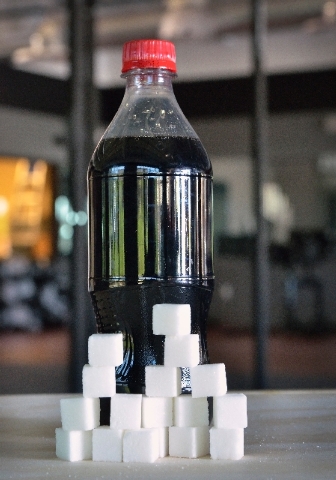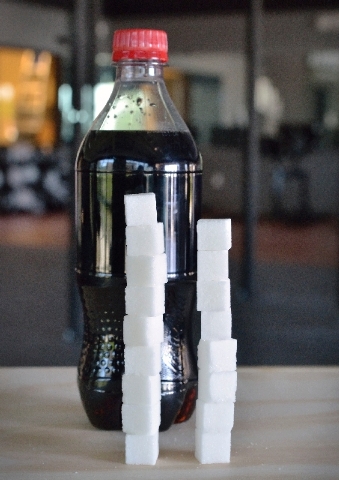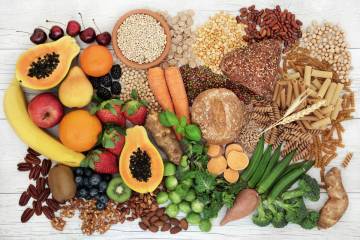Stay out of shu-shu-sugartown …
“Death of the Diet” is my own nutrition philosophy that I enjoy sharing. It means to quit dieting. Just eat better, one step at a time.
No more celebrity slim-down or get-ripped diets. No more cleanses, detoxes, point systems, magic solutions or Jedi mind tricks. Just eat better. Progress your own nutrition program like you would your gym program — one step at a time. For example, this week cut out the soda and next week put together a nutritious breakfast. Use weekly or even daily objectives to progress your nutrition to a peak of excellence.
Let’s talk sugar. To help me out, I have brought a registered dietitian to the metaphorical table. Because I don’t have a degree in nutrition or residency hours to get registered, Kathryn Vasaeli of Wellness Coaches USA was “sweet” enough to let me interview her about this tasty topic. Not being licensed to practice nutrition counseling, I was relieved to find out that my death of the diet ideal fell in line with her thinking. “Just eat better” and “eat real food” were some recurring themes in our discussion.
“Natural” sugars occur in nature in the form of simple and complex carbohydrates, Kathryn explained. Molecularly, simple carbohydrates are found in plant and dairy products. Complex carbohydrates have a complex molecular makeup. These carbs are found in foods such as starchy vegetables, legumes and whole grain products. Simple carbs are broken down faster than complex carbs so they enter the bloodstream faster. The body breaks down carbohydrates into various kinds of “sugars” to be used for energy. This sugar is the good stuff. Carbs are the body’s first fuel source because it goes straight to the muscles to move the body. Simple and complex carbs, in their proper portions, are nutritious and good for the body.
Specifically, fructose and glucose are single sugar molecules while lactose, maltose and sucrose are double molecules, Kathryn explained. Fructose is found in fruits and breaks down into glucose in the liver. Glucose is what the body prefers to use for energy. That’s why it’s coursing through the bloodstream, so it can be delivered to wanting muscles. Other sugars take longer to break down because of their more complex makeup.
“Added” sugar is where we as Americans can really get into trouble. These are table sugar, brown sugar and high fructose corn syrup. Research shows they increase triglycerides, lower the good HDL cholesterol and raise the bad LDL cholesterol. They also increase the risk of coronary heart disease and high blood pressure as well as promote inflammation.
Exercise can affect blood sugar. When you move around, your muscles use up their supply of glucose and the body rushes to replace it. This means that the pancreas works hard to produce insulin so the cells can uptake the glucose. Exercise lowers blood sugar and makes your body’s insulin work better. Even hours after physical activity, the body is moving glucose through the bloodstream and insulin is helping it get into cells.
Sugar can relate to obesity. When your body has the right amount of sugar, it functions properly. The body has energy, hormone levels are looking good and you can see your feet. If there just so happens to be an excess of sugar in the body, it gets stored as triglycerides in fat cells. Then let’s say you don’t exercise and the fat remains stored and you continue to eat at a surplus. After a while you have accumulated so much storage you need to buy larger pants.
All of your sugar intake during the day should be about 6 teaspoons (24 grams) for women and 9 teaspoons for men (36 grams), Kathryn said. The average American eats 22 teaspoons (86 grams). That’s anywhere from a quarter to a third of a person’s daily calories.
Let’s make a visual. A daily dose of sugar is six sugar cubes for women and nine for men. The average American eats 21 sugar cubes. That is more than double. Now imagine this same surplus multiplied over 365 days. Holy chocolate frosting, Batman! The number is daunting and scary.
If obesity were the lone side effect related to excess of sugar in the body, we could count ourselves lucky. The chemistry set that is our body reacts in various ways to imbalances. As Kathryn puts it, there is a “cascade effect.” Insulin is secreted from the pancreas to help the body process glucose. If there is a large amount of glucose to process, the pancreas must put out that much more insulin. After a while, the body becomes resistant to insulin and/or the pancreas cannot produce enough insulin for the sugar consumed. This leads to Type 2 diabetes. Also, excess glucose consumed is converted into triglycerides and stored in adipose tissue, increasing body-fat percentages. Because of the excess mass, the heart has to work harder to pump blood through the body. Now we have cardiovascular issues on top of insulin sensitivity and obesity.
Consuming too much sugar can increase the risk for Type 2 diabetes, heart disease and stroke. Before those big issues take hold, you become insulin resistant. The common symptoms are fatigue, depression, water retention, weight gain and irregular bowl movements. Sound like anyone you know?
Let’s try to avoid a cascade failure of our bodies. Eat real food. Real food has one ingredient. It is so apparent that you don’t need to check the label. Broccoli is broccoli. Chicken is chicken. Real food expires by way of decomposition. Fake food has a shelf life noted by the “consume by” date on the package. Avoid processed or “added” sugar.
Kathryn advises to “fix the inside (of the body), and the outside will come.” She means eat right and then things such as weight loss will follow. She also advises to read the labels. Just because a product has a buzzword such as “low-carb,” “sugar-free” or “diet” doesn’t necessarily mean you should eat it. The more you learn about how your individual body reacts to the food you put into it, the better food choices you can make.
To give you a visual, I recommend stacking sugar cubes to represent the amount of sugar in your favorite products. One sugar cube equals 4 grams of sugar. Featured is a soft drink with 16 sugar cubes. That is more than double the recommended amount.
If you have any doubts about your nutrition, see a registered dietitian. They have the schooling and expertise needed to prescribe the correct nutrition for you. If you have nutrition questions for Kathryn Vasaeli, she can be reached at kvasaeli@gmail.com.
Chris Huth is a Las Vegas trainer. If you are a Las Vegas trainer and want to share your love of fitness as a guest coach, feel free to contact him. He can be reached at 702trainer@gmail.com. Consult your physician before beginning any exercise program.



















